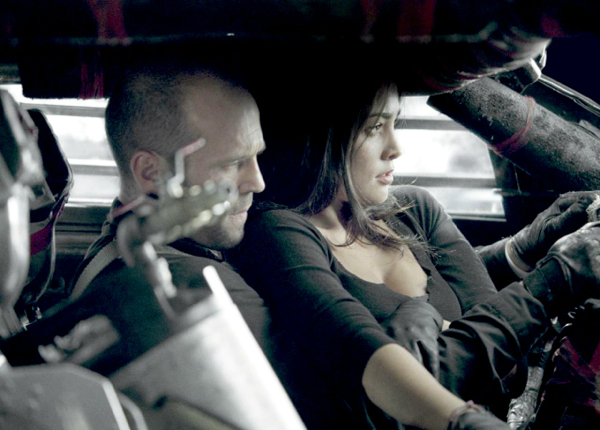Movie review by Greg Carlson
A trashy update (in name only) of 1975’s Paul Bartel/Roger Corman “Death Race 2000,” “Death Race” continues to blur the line between motion picture entertainment and video game. So it will come as no surprise that the movie’s director is Paul W.S. Anderson, the helmer behind “Mortal Kombat” and “Resident Evil.” For genre fans, the movie fulfills its modest expectations: drivers pilot souped-up, armored vehicles around an industrial prison track, attempting to kill each other on the way to the finish line. Automotive mayhem dominates the reasonably tight running time at the expense of nuance and subtext, but the target audience is highly unlikely to mind.
Jason Statham, a terrific physical screen presence who just needs a couple of meaty roles to lift him out of the ghetto of typecast in which he toils (in, among even lesser things, one “Transporter” movie after another), plays protagonist Jensen Ames, an honest, hardworking family man framed for the murder of his wife. Sent to Terminal Island, a corporate-run maximum security correctional facility, Ames is strong-armed into accepting a role as a replacement contestant in Death Race, a pay-per-view money machine overseen by steely-eyed warden Hennessey (Joan Allen, playing so tight she turns coal into diamond).
Partnered with the wise lifer Coach (Ian McShane, perpetually awesome, even when stuck with dialogue light years from Al Swearengen), Ames at first reluctantly agrees to put pedal to metal, but warms up to the contest when he realizes it affords him an opportunity to directly avenge the death of his beloved. Anderson stakes out three rounds of behind-the-wheel carnage, and pauses briefly in between to connect the dots of Ames’ predicament. The look of the movie maintains a dingy palette of gun-metal gray, and the overall effect of the desaturation numbs the viewer.
Hilariously, albeit unintentionally, “Death Race” juices its erotic appeal by partnering the doomed road warriors with bombshell female “navigators” recruited from a nearby women’s lockup. With the exception of Tyrese Gibson’s Machine Gun Joe, who prefers the company of men, the cartoonish competitors rev their engines with women in the passenger seats, but the movie has no interest in exploring the dynamics of the unlikely pairings, a disappointing choice since the entire Death Race enterprise is supposedly concerned with boosting ratings among its fictional audience. Anderson sneaks in one cozy moment between Ames and Natalie Martinez’s character Case, but it is in the service of setting up a big explosion, not sex.
“Death Race” sidesteps its camp potential far too often, and the absence of humor will make it a long road trip for some viewers. As an architect of burning rubber, Anderson fails more often than he succeeds, choosing a frantic, rapid-fire editing style that refuses to stick with any one image long enough for it to have presence or authority. Occasionally, the director manages to string together some shots that cohere, but most of the time the viewer has no grasp of the racers’ positions on the course. At one point, the warden remarks that her paying customers can select preferred angles during the matches. If only the movie patron could do the same.
